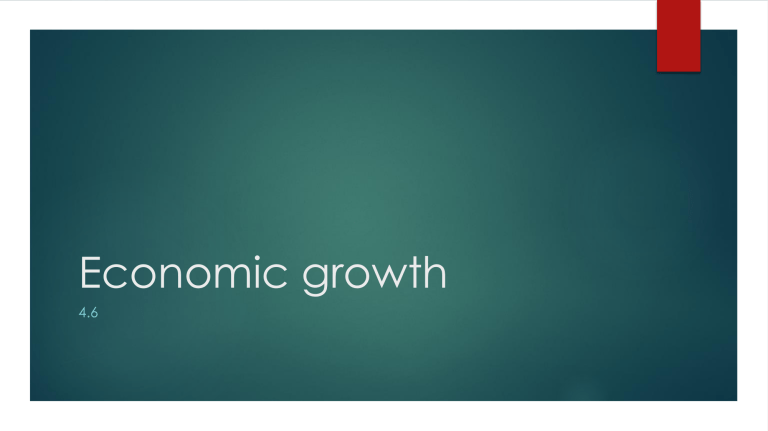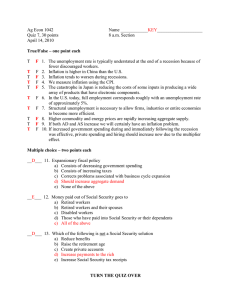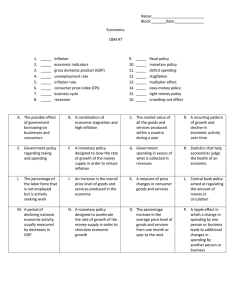
Economic growth 4.6 Objectives ► AO1 understand the meaning of economic growth ► AO2 be able to determine the causes and consequences of an economic recession and economic growth ► AO3 be able to evaluate the policies promoting economic growth Key terms ► Economic growth ► Nominal economic growth ► Real economic growth ► Real economic growth per capita ► Actual economic growth ► Potential economic growth ► Recession ► Sticky wages – wage rate cannot move down despite lack of demand ► Quantitative easing – increasing the money supply ► Bubble – prices are driven higher than the true value of the asset Economic growth ► Economic growth - an increase in the production of goods and services over a specific period. ► Nominal economic growth - does not take inflation into account ► Real economic growth – nominal economic growth less the inflation rate ► Real economic growth per capita - real economic growth per person ► Actual economic growth – an outward shift of AD ► Potential economic growth – an outward shift of AS ► Economic growth Economic growth Economic growth The economic cycle Actual economic growth Changes in total demand may increase the utilisation of resources and GDP – resulting in a movement from inside toward the PPC Potential economic growth Economic growth shifts the economy’s PPC to the right and is caused by changes in investment, technology, and the quantity and quality of the factors of production Recession A recession is a significant decline in economic activity spread across the economy, lasting more than a few months, normally visible in real GDP, real income, employment, industrial production, and wholesale-retail sales.. Possible causes of a recession – demand-side Major “negative” demand-side shocks hitting the components of AD a. A global economic slump or a deep recession in the country of a major trading partner such as the countries of the EU (60% of UK trade) and the United States (15% of UK trade) b. A sharp fall / collapse in asset prices e.g. share prices, property prices c. A credit crunch where financial institutions cut back the amount of credit they are prepared to lend to households and businesses and raise the interest rate on these loans d. A large appreciation of the exchange rate which hits demand for exports, raises import demand and causes the trade balance to worsen Possible causes of a recession – supplyside Major inflationary supply-side shocks which affect SRAS a. Higher crude oil and gas prices – leading to increased input costs, driving inflation higher and causing a fall in real incomes for households (less consumption) and a fall in profits for businesses (less investment and possible employment cut-backs) – this is known as stagflation b. Higher prices for metals and other non-fuel inputs c. Surge in foodstuff prices which increase costs and lower profits for food manufacturers d. Other inflationary effects globally such as a sharp rise in inflation in the USA or China, leading to a burst of imported inflation e. If wages remain sticky there is a danger of a wage-price spiral emerging. Possible causes of a recession – government policy Risks of recession arising from deflationary macroeconomic policies such as higher interest rates or increased direct and indirect taxation a. If interest rates are raised to counter higher inflation from the domestic economy or from overseas – this can cause a fall in confidence, less spending and a downturn in output and jobs b. Taxes may have risen to counter a budget deficit – squeezing real disposable incomes and demand or perhaps damaging business investment Recession causes Supplyside Demandside Costs and benefits of economic growth Main Benefits of Economic Growth ► Higher living standards – i.e. Real GNI per capita – helps to lift people out of extreme poverty and improve development outcomes (e.g. rising HDI) ► Employment effects – sustained growth stimulates jobs and contributes to lower unemployment rates which is turn helps to reduce income inequality. ► Fiscal dividend – higher economic growth will raise tax revenues and reduce government spending on unemployment & poverty related welfare benefits Main Costs of Economic Growth ► ► ► Risks of higher inflation and higher interest rates ► Fast-growing demand can lead to inflation – this leads to a conflict between macro objectives ► The central bank may decide to raise interest rates to control inflation Environmental effects ► More negative externalities such as pollution & waste ► Risk of unsustainable extraction of finite resources – i.e. fast growing countries may cause a long-run depletion of natural resources Inequalities of income and wealth ► Rapid increases in real national income can lead to a higher level of inequality and social divisions ► Many of the gains from growth may go to only a few people Policies to promote economic growth ► Government policies to increase economic growth are focused on trying to increase aggregate demand (demand side policies) or increase aggregate supply/productivity (supply side policies) ► Demand side policies include: ► ► Fiscal policy (cutting taxes/increasing government spending) ► Monetary policy (cutting interest rates) Supply side policies include: ► Privatisation, deregulation, tax cuts, free trade agreements (free market supply side policies) ► Improved education and training, improved infrastructure. (interventionist supply side policies) Policies for economic growth Monetary Policy Monetary policy is the most common tool for influencing economic activity. To boost AD, the Central Bank (or government) can cut interest rates. Lower interest rates reduce the cost of borrowing, encouraging investment and consumer spending. Lower interest rates also reduce the incentive to save, making spending more attractive instead. Lower interest rates will also reduce mortgage interest payments, increasing disposable income for consumers Monetary policy Evaluation of Monetary Policy ► Lower interest rates may not always boost spending because people are trying to pay back debts. In 2009, UK interest rates were cut to 0.5%, but spending remained subdued. Banks were unwilling to lend because of liquidity shortages. Therefore, although in theory, it was cheap to borrow, it was hard to actually create credit. After a recession firms and consumers are lacking confidence and so may not borrow due to the perceived risks involved. Therefore, this shows monetary policy can be ineffective in boosting economic growth ► Another criticism of monetary policy is that cutting interest rates very low could distort future economic activity. For example, the US cut interest rates following the economic uncertainty of 9/11. These low-interest rates encouraged people to take on ambitious loans and mortgages; this was a factor behind the US housing bubble. Therefore cutting interest rates, at the wrong time, can contribute to a future housing and asset bubble which will destabilise economic growth. However, in 2009-12, the depth of the financial crisis means there is no immediate danger of a housing bubble, so it was appropriate to keep interest rates at zero. Evaluation of fiscal policy ► The government can boost demand by cutting tax and increasing government spending. Lower income tax will increase disposable income and encourage consumer spending. Higher government spending will create jobs and provide an economic stimulus. ► The problem with expansionary fiscal policy is that it leads to an increase in government borrowing. To finance this extra spending, the government have to borrow from the private sector. ► However, if the economy sees a rapid fall in private spending, and a rise in the saving ratio, expansionary fiscal policy can help provide a boost to demand in the economy Fiscal policy - evaluation Evaluation of devaluation ► Devaluation can help restore competitiveness and boost domestic demand. A fall in the exchange rate makes exports cheaper and imports more expensive. ► The disadvantage of devaluation is that it can lead to short-term economic pain. Rising import prices increase inflation and reduce standards of living. Devaluation is also seen as a sign of economic and political weakness. Key terms ► Economic growth ► Nominal economic growth ► Real economic growth ► Real economic growth per capita ► Actual economic growth ► Potential economic growth ► Recession ► Sticky wages ► Quantitative easing ► Bubble Objectives ► AO1 understand the meaning of economic growth ► AO2 be able to determine the causes and consequences of an economic recession and economic growth ► AO3 be able to evaluate the polices promoting economic growth







